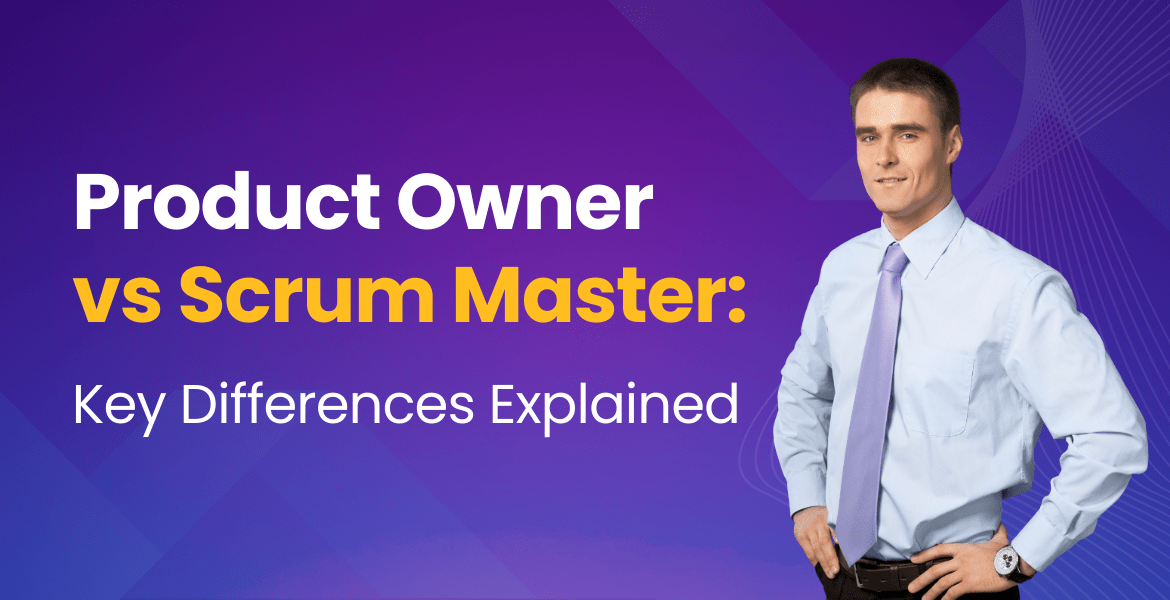Product Owner vs Scrum Master: Key Differences Explained
December 6, 2024 2024-12-09 10:15Product Owner vs Scrum Master: Key Differences Explained

Product Owner vs Scrum Master: Key Differences Explained
In the world of Agile, the roles of Product Owner and Scrum Master are essential, yet very different. Both roles work closely within Scrum teams, but they serve unique functions and have distinct responsibilities. Whether you are considering pursuing a career in Agile or are just curious about how these two roles differ, understanding their responsibilities is crucial for the success of any Scrum team.
In this blog, we will explore the key differences between the Product Owner and Scrum Master roles. We will also discuss the benefits of Scrum Master certification, how it can help you succeed in the Scrum Master role, and why getting the best Agile Scrum certification matters for your career.
1. Understanding the Product Owner Role
The Product Owner (PO) is the person responsible for managing the product backlog and ensuring the team works on the right tasks at the right time. The Product Owner is the link between the business and the Scrum team, representing the voice of the customer and the business stakeholders.
Here are the core responsibilities of a Product Owner:
a) Defining the Product Backlog
The Product Owner creates and manages the product backlog, which is a list of all the work items or tasks that need to be completed for the product. This includes new features, improvements, bug fixes, and technical debt. They prioritize the backlog items based on business value, customer needs, and other factors, making sure that the team works on the most important tasks first.
b) Prioritizing Work
The Product Owner prioritizes the work based on the needs of the business and customers. They need to make tough decisions about what features or tasks to work on first, balancing different stakeholders’ expectations. This can involve working with stakeholders to gather feedback and adjust priorities as the project progresses.
c) Clarifying Requirements
During the Sprint, the Product Owner works closely with the team to clarify requirements. They answer questions, provide details, and ensure the team has a clear understanding of what needs to be done. The Product Owner ensures that each user story or task is well-defined and understood by the team before work begins.
d) Maximizing Product Value
Ultimately, the Product Owner’s job is to maximize the value of the product being built. They do this by ensuring that the team focuses on delivering high-priority features that bring the most value to customers and stakeholders. They also help the team understand the bigger picture, ensuring that every piece of work contributes to the overall product vision.
2. Understanding the Scrum Master Role
The Scrum Master is a servant-leader for the Scrum team, responsible for helping the team follow Scrum processes and practices. While the Product Owner focuses on the “what” and “why” of the product, the Scrum Master focuses on the “how” the team works together and follows the Scrum framework. The Scrum Master removes obstacles that may hinder the team’s progress and ensures that the Scrum process is running smoothly.
Here are the core responsibilities of a Scrum Master:
a) Facilitating Scrum Events
The Scrum Master facilitates key Scrum events like Sprint Planning, Daily Scrum (stand-ups), Sprint Review, and Sprint Retrospective. They ensure these events are productive, stay on track, and that the team follows the Scrum rules. The Scrum Master ensures the team is focused and helps resolve any issues that arise during the events.
b) Removing Obstacles
One of the most important roles of a Scrum Master is to remove any obstacles or impediments that might slow down the team’s progress. These could be technical issues, conflicts within the team, or external factors like a lack of resources. The Scrum Master helps identify and solve these problems quickly so the team can continue working effectively.
c) Coaching the Team
The Scrum Master is also a coach for the team, helping them become more self-organized and improving their Agile practices. They guide the team in understanding and following Scrum rules, encourage collaboration, and help them continuously improve their processes. The Scrum Master also coaches the Product Owner on how to manage the backlog effectively and works to ensure good communication between the Product Owner and the team.
d) Supporting a Collaborative Culture
The Scrum Master ensures that the team collaborates effectively and works well together. They help resolve conflicts, encourage open communication, and create a safe environment where team members feel comfortable sharing ideas and concerns. The Scrum Master also works to build a positive, self-sustaining team culture that leads to continuous improvement.
3. Benefits of Scrum Master Certification
Becoming a certified Scrum Master can provide numerous benefits, both for individuals and organizations. A Scrum Master certification gives you a solid foundation in Scrum principles, practices, and techniques. Here are some of the main benefits of Scrum Master certification:
a) Increased Career Opportunities
A Scrum Master certification is highly valued by employers, as it shows that you have a solid understanding of Scrum and Agile methodologies. With this certification, you can increase your job opportunities and enhance your chances of landing roles in Agile environments.
b) Better Job Performance
Having the right knowledge and skills helps you perform better as a Scrum Master. Scrum Master certification prepares you to handle real-world challenges, such as facilitating meetings, removing obstacles, and coaching teams to improve. This knowledge can make you a more effective Scrum Master and enable your team to succeed.
c) Improved Team Collaboration
As a certified Scrum Master, you will be better equipped to guide your team through the Scrum process, ensuring smoother collaboration and better communication. You’ll also be able to support the team in continuous improvement, creating an environment where they can work more effectively.
d) A Competitive Edge
In a competitive job market, having a recognized Scrum Master certification like the ones offered by Aabiance can give you a significant edge over other candidates. Employers look for candidates who are certified, as it shows they have the expertise and commitment to Scrum practices.
4. Why Choose the Best Agile Scrum Certification?
When it comes to choosing a Scrum Master certification, you want to go with a trusted and reputable certification provider. Programs like Aabiance offer high-quality training and certification that are recognized globally. Getting the best Agile Scrum certification ensures that you are learning the most up-to-date Scrum practices and are well-prepared for the challenges you may face in real-world Agile projects.
A good certification program will not only teach you the basics but also provide you with advanced techniques and strategies to help you excel in your role. Whether you’re just starting your career or looking to advance your skills, getting the best Agile Scrum certification is a smart investment in your future.
Conclusion
In summary, while the Product Owner and Scrum Master both play vital roles in a Scrum team, they have very different responsibilities. The Product Owner focuses on the product, prioritizing the backlog and making sure the team works on the right tasks to deliver value. The Scrum Master, on the other hand, focuses on the Scrum process, facilitating meetings, removing obstacles, and coaching the team to work more effectively.
If you’re interested in becoming a Scrum Master or improving your skills in this role, obtaining a Scrum Master certification can be a valuable step. The benefits of Scrum Master certification include better career opportunities, improved job performance, and the ability to help your team succeed. With the right certification, such as those offered by Aabiance or the best Agile Scrum certification programs, you can take your Scrum Master skills to the next level and make a meaningful impact on your team’s success.







